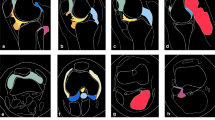Abstract
Tenosynovial giant cell tumor-diffuse type (diffuse TSGCT) is a benign but locally aggressive proliferative disorder of the synovium. Treatment is usually surgical, although in cases of extensive disease complete synovectomy is not possible and local recurrence rates are high. Pexidartinib (trade name Turalio®), a colony-stimulating factor-1 (CSF-1) inhibitor, was shown in a recent phase III trial to effectively treat diffuse TSGCT and is FDA approved for the treatment of adult patients with symptomatic diffuse TSGCT associated with severe morbidity or functional limitations and not amenable to improvement with surgery. Pexidartinib is available only through a restricted program under a risk evaluation and mitigation strategy (REMS) because of the risk of hepatotoxicity. Magnetic resonance imaging (MRI) is the preferred imaging modality for the diagnosis and surveillance of TSGCT. Here we present three patients with diffuse TSGCT of the knee who underwent multiple MRIs over several years while on pexidartinib. We describe the disease burden and signal characteristics on MRI and correlate with the response reported in the patients’ medical records. Given that the use of pexidartinib and other CSF inhibitors is likely to increase, musculoskeletal radiologists should be aware of this novel non-operative treatment and the MRI appearance of diffuse TSGCT during therapy.



Similar content being viewed by others
References
Lin C, Kang Y, Lan K, et al. treatment and outcome of tenosynovial giant cell tumor/pigmented villonodular synovitis patients receiving radiotherapy in Taiwan: a single-center experience. Ther Radiol Oncol. 2020;4:14.
Ehrenstein V, Andersen SL, Qazi I, et al. Tenosynovial giant cell tumor: incidence, prevalence, patient characteristics, and recurrence. A registry-based cohort study in Denmark. J Rheumatol. 2017;44(10):1476–83.
Steinmetz S, Rougemont AL, Peter R. Pigmented villonodular synovitis of the hip. EFORT Open Rev. 2016;1(6):260–6.
Tap D, Gelderblom H, Palmerini E, et al. Pexidartinib versus placebo for advanced tenosynovial giant cell tumour (ENLIVEN): a randomized phase 3 trial. Lancet. 2019;394(10197):478–87.
Darling JM, Goldring SR, Harada Y, Handel ML, Glowacki J, Gravallese EM. Multinucleated cells in pigmented villonodular synovitis and giant cell tumor of tendon sheath express features of osteoclasts. Am J Pathol. 1997;150(4):1383–93.
Frassica FJ, Bhimani MA, McCarthy EF, Wenz J. Pigmented villonodular synovitis of the hip and knee. Am Fam Physician. 1999;60(5):1404–10 discussion 1415.
Jain JK, Vidyasagar JV, Sagar R, Patel H, Chetan ML, Bajaj A. Arthroscopic synovectomy in pigmented villonodular synovitis of the knee: clinical series and outcome. Int Orthop. 2013;37(12):2363–9.
Temponi EF, Barros AAG, Paganini VO, Barbosa VAK, Badet R, Carvalho Júnior LH. Diffuse pigmented villonodular synovitis in knee joint: diagnosis and treatment. Rev Bras Ortop. 2017;52(4):450–7.
Mollon B, Lee A, Busse JW, et al. The effect of surgical synovectomy and radiotherapy on the rate of recurrence of pigmented villonodular synovitis of the knee: an individual patient meta-analysis. Bone Joint J. 2015;97-b(4):550–7.
West RB, Rubin BP, Miller MA, et al. A landscape effect in tenosynovial giant-cell tumor from activation of CSF1 expression by a translocation in a minority of tumor cells. Proc Natl Acad Sci U S A. 2006;103(3):690–5.
Cheng XG, You YH, Liu W, Zhao T, Qu H. MRI features of pigmented villonodular synovitis (PVNS). Clin Rheumatol. 2004;23(1):31–4.
Narváez JA, Narváez J, Ortega R, De Lama E, Roca Y, Vidal N. Hypointense synovial lesions on T2-weighted images: differential diagnosis with pathologic correlation. AJR Am J Roentgenol. 2003;181(3):761–9.
Murphey MD, Rhee JH, Lewis RB, Fanburg-Smith JC, Flemming DJ, Walker EA. Pigmented villonodular synovitis: radiologic-pathologic correlation. Radiographics. 2008;28(5):1493–518.
Sheth PJ, Del Moral S, Wilky BA, et al. Desmoid fibromatosis: MRI features of response to systemic therapy. Skeletal Radiol. 2016;45(10):1365–73.
Author information
Authors and Affiliations
Corresponding author
Ethics declarations
Consent for publication
Consent for publication was obtained for every individual person’s data included in the study.
Conflict of Interest
The authors declare no competing interests.
Additional information
Publisher's note
Springer Nature remains neutral with regard to jurisdictional claims in published maps and institutional affiliations.
Rights and permissions
About this article
Cite this article
Helming, A., Hansford, B. & Beckett, B. Tenosynovial giant cell tumor-diffuse type, treated with a novel colony-stimulating factor inhibitor, pexidartinib: initial experience with MRI findings in three patients. Skeletal Radiol 51, 1085–1091 (2022). https://doi.org/10.1007/s00256-021-03924-3
Received:
Revised:
Accepted:
Published:
Issue Date:
DOI: https://doi.org/10.1007/s00256-021-03924-3




